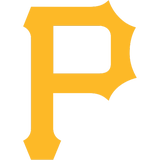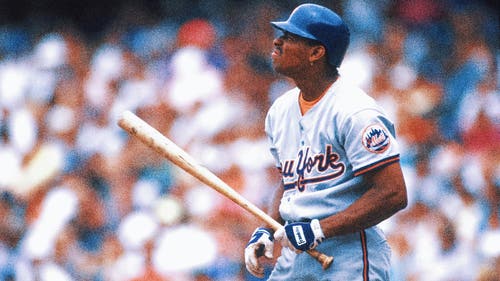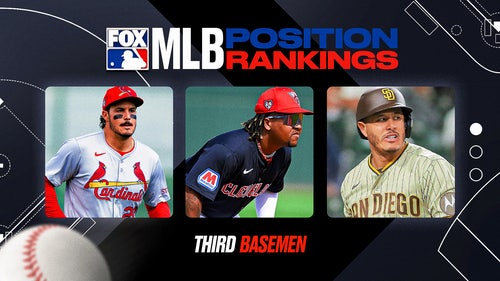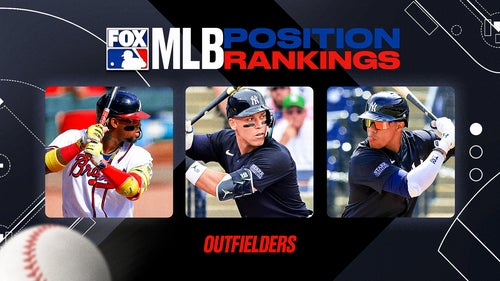
South Africa's Gift Ngoepe joins an exclusive list of baseball's continental pioneers
On Wednesday night, a bit of baseball history was made with the debut of Gift Ngoepe. Called up by the short-handed Pirates, the 27-year-old second baseman became the first Africa-born player to play in the major leagues when he entered a game against the Cubs as part of a double switch in the top of the fourth inning. In the bottom of the frame, the South Africa native made another bit of history by stroking a clean single up the middle off Jon Lester.
Baseball's efforts to broaden the game's reach beyond North America date back to the 19th century. The game was introduced into Cuba in 1860, into China in 1863, and into Japan and Korea in the early 1870s, just as the first major league, the National Association, was getting started in the U.S. In the winter of 1873–74, Harry Wright “the father of professional baseball,” took his Boston Red Stockings and the rival Athletic of Philadelphia to England for a series of exhibitions that was a financial flop. In 1889, Albert Goodwill Spalding, who had starred as a pitcher in the nascent National Association (1871–75) and National League (1876–77), organized a more successful six-month international barnstorming tour featuring major league stars in an effort both to brand the game as uniquely American (despite its apparent derivation from the English bat-and-ball game of rounders) and to expand Spalding's market for sporting goods. They made stops in Australia, New Zealand, Egypt (to a six-year-old learning about the game, this famous photo was the original “Riddle of the Sphinx”) and Europe. More recently, Major League Baseball's international efforts have included not only the placement of expansion teams in Canada but opening the regular season in Monterrey (1999), Tokyo (four times, first in 2000) and Sydney (2014) and introducing the World Baseball Classic tournament in 2006.

As a small-market, forward-thinking team (at least in recent years), the Pirates have taken a high profile in their international efforts. They signed Dinesh Patel and Rinku Singh, two Indian athletes who beat out some 37,000 other contestants in a competition to find the country's fastest pitcher for a reality television show called The Million Dollar Arm (later dramatized in a movie of the same name); the latter was still active as of last year but neither played above A-ball. Ngoepe, who replaced the majors’ first Lithuania-born pitcher, Dovydas Neverauskas on the Pirates’ roster, literally grew up in a baseball clubhouse in a suburb of Johannesburg. His mother cooked, cleaned and cashiered for a white amateur team called the Randburg Mets in exchange for being able to live in the tiny clubhouse. After playing for the South African national team, Ngoepe caught the eye of Barry Larkin at MLB's European Academy in 2007, was signed by the Pirates in 2008, and hit a pair of triples off major leaguer Elmer Dessens in the 2009 WBC; he began his stateside career that year. Suffice it to say, he’s taken a long road to the majors.
With Ngoepe's debut, every continent except Antarctica has produced at least one major league player (no, "The Penguin," Ron Cey, is a native of Washington state). What follows here is a quick international tour of the major league groundbreakers from each continent, in chronological order.
The National Association of Professional Base Ball Players was the first professional baseball league, but its status as a major league is a contentious one. In 1969, MLB's Special Baseball Records Committee ruled that it was not one due to its erratic scheduling, poor newspaper coverage and other irregularities, but historians have argued otherwise (even in the pages of Sports Illustrated). While its statistics weren't included in the landmark 1969 Macmillan Baseball Encyclopedia, they are on Baseball-Reference.com.
Because of a rainout in Washington, DC (more on which momentarily), the first NA league game took place May 4, 1871 between the Cleveland Forest Citys and the Fort Wayne Kekiongas. Technically, all 18 players can claim "first" status, but Mathews faced White in the first batter-pitcher confrontation in league history. White, Cleveland's catcher, doubled for the first hit in league history (he was doubled off second base during the next at-bat). Cleveland was held scoreless that day by the 5' 5", 140-pound Mathews, who scattered four hits and struck out six en route to the first of his 297 major league wins, a 2–0 victory that was the league's lowest-scoring affair of the season. White, who won batting titles in the NA (1875, its final year) and NL (1877), and who believed the earth was flat was elected to the Hall of Fame by the 2013 Pre-Integration Committee.
A day after the aforementioned showdown between Cleveland and Fort Wayne, the Boston Red Stockings faced the Washington Olympics in Washington, DC, the matchup that was intended to inaugurate the NA. The Red Stockings featured five players from the Cincinnati Red Stockings, the first fully professional team, who had gone undefeated the year before in the National Association of Base Ball Players, the first organized league dating back to 1857. The Sheffield, England-born Wright, that team's manager and regular centerfielder, moved to Boston to be part of the new NA, bringing brother George, a shortstop, with him as well as two other players; the rest of the Cincinnati team, whom Wright eschewed because he wanted "no drinkers, growlers or shirkers" on his team, signed with Washington.

With Wright winning the toss, Boston chose to be the home team, which sent Hall, Washington's Stepney, England-born leftfielder, to the plate first amid a six-run first inning against the 21-year-old Spalding; Hall beat out a single to shortstop, and two batters later, Wright's bases-loaded muff of a fly ball let in three runs. Wright himself flew out in his first plate appearance, but he did get a hit and score twice in Boston's 20-18 come-from-behind win. Wright, who manged the Red Stockings to four NA and two NL pennants, was elected to the Hall of Fame in 1953. Hall, who would play for Wright in 1874, was the NL's first home run champ with five for the Philadelphia Athletics in 1876.
Born in Ipswich, Queensland, Australia to refugees of the Irish potato famine, Quinn and his family came to the U.S. around 1872, when he was 10 years old. Living in Dubuque, Iowa, where his father mined zinc and the family lived in poverty, he took up baseball, which was his ticket to fitting in. After playing on a semipro team, the Dubuque Rabbits, with future Hall of Famers Old Hoss Radbourn and Charlie Comiskey, Quinn joined the St. Louis Maroons of the upstart Union Association (another league whose major status remains in dispute) in 1884. Though he stood just 5' 7", he was the regular first baseman for a team that went 94-19 for an .817 winning percentage, a mark that remains unsurpassed at the major league level.
The UA only lasted one season but Quinn continued playing as the Maroons moved to the NL. All told, he spent 17 years in the majors, hitting a thin .262/.303/.328 in a career that passed through eight teams including the notorious 1899 Cleveland Spiders, who after being gutted by syndicate owners who sent their best players— including Cy Young—to St. Louis set a record for futility with a 20–134 record and a .130 winning percentage. Quinn was their manager as they lost 104 of their final 116 games. His final stop was with the Washington Senators in 1901, the year that the American League was established. It would take until 1986 before a second Australian-born player, infielder Craig Shipley, reached the majors with the Dodgers.
Kingman was born on April 3, 1892 in Tientsin, China to missionaries; his father was an American from New York, his mother the China-born daughter of an English missionary. Reverend Henry Kingman's asthma led him to return to the U.S. In 1899, when he accepted a job as the chaplain of Pomona College in Claremont California, where his son, despite being a poor student, starred in five sports including baseball. After playing in the short-lived Southern California League in 1913, Kingman signed with the Washington Senators, but by the time he reached Washington, DC, he had been traded to the Yankees, who were managed by ex-Cubs first baseman Frank Chance, a California native who was likely familiar with his prowess.

Chance tried to make the 6' 1" lefty a pitcher, but he never got the hang of it. He played in just four major league games, three as a pinch-hitter and one as a first baseman, going 0-for-3 with a walk. According to Society for American Baseball Research biographer Bob Timmermann, Kingman "had such a distinguished and far-ranging post-baseball career that one can research him by accessing a collection of his private papers at the University of California at Berkeley, which includes a handwritten letter by Mahatma Gandhi and a postcard from H.G. Wells." To date, he's the only major leaguer born in mainland China. It would take until 1964, when Japanese pitcher Masanori Murakami pitched for the Giants, for the continent to produce another major leaguer.
According to naturalization forms he filled out in 1917, Castro was born in Medellin, Colombia on November 25, 1876, though at times in his life he claimed to have been born in New York City (where his well-to-do family had emigrated in the early 1880s), perhaps due to anti-immigrant sentiment. Castro took up baseball at Manhattan College High School, and starred at Manhattan College; by 1898, Sporting Life recognized him as one of the east coast's top collegiate players. He began playing minor league baseball in 1898, and in 1902 joined the Philadelphia A's, where he was saddled with the tall task of replacing future Hall of Famer Napoleon Lajoie, whom the team lost to Cleveland in a contract dispute.
Though at one point he reeled off a 10-game hitting streak, Castro hit a light .245/.265/.336 in 42 games and was found wanting defensively; he turned more errors than double plays and was replaced in the lineup. Worse, he was rejected by Baltimore Orioles manager Wilbert Robinson after AL president Ban Johnson canvassed the league to drum up replacements once John McGraw jumped the team for the NL’s Giants, taking several other Orioles with him. The A's went on to win the AL pennant, but Castro returned to the minors, where he knocked around through 1912.
It would take until 1939 for the next South America-born player, Venezuelan pitcher Alex Carrasquel, to come along. As the scout who signed Minnie Minoso (the majors’ first black Latin American player) and the uncle of Chico Carrasquel, the first Latin American player to start an All-Star Game, he would figure prominently in opening the floodgates to Latin American players, but that’s a story for another day.






